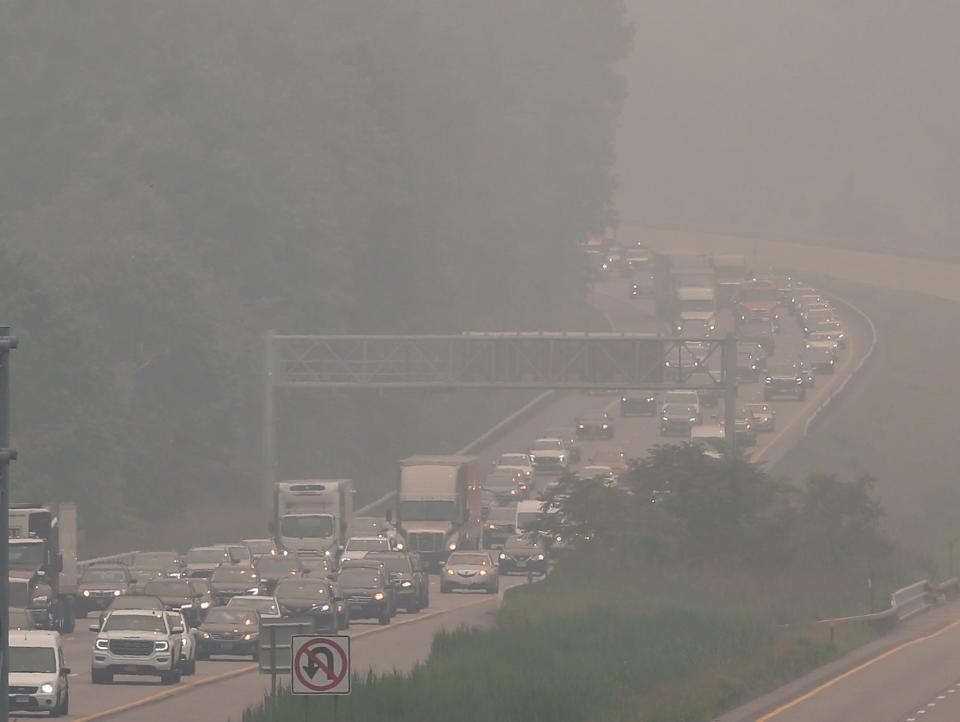Wildfire smoke expected to blanket New York this week. What to know
Smoke from Canada's raging wildfires is expected to blanket New York State on Wednesday, raising unhealthy air quality levels – again.
A cold front entering Western New York from the Upper Midwest early Wednesday morning is projected to bring near-surface smoke statewide, New York officials said. Unhealthy air levels are expected in western and central New York on Wednesday, with smoke wafting downward toward the Hudson Valley and the New York City metropolitan area by Thursday.
"We certainly expect that smoke to continue its march through New York State," Basil Seggos, the commissioner of the state Department of Environmental Conservation (DEC), told reporters Tuesday afternoon, shortly after the state issued air quality advisories.
For air quality updates, visit the federal website airnow.gov.

How bad is breathing in wildfire smoke? Graphics show how toxic air affects your health
In recent weeks, officials have warned of fine particulate matter caused by Canada's historic wildfires that have harmful effects on respiratory health.
"As we closely monitor the changing forecast, New Yorkers should be prepared for the potential return of smoke from the Canadian wildfires," Gov. Kathy Hochul said in a statement. "I encourage everyone to remain vigilant, especially if you are vulnerable to air pollution, stay up to date on the latest information and take steps to protect yourself."
The state DEC and Department of Health issued air quality health advisories − for when pollutants such as fine particulates or ozone exceed a federal air quality index of 100 − to the Western New York, Central New York and Eastern Lake Ontario, which includes Rochester, regions for wildfire smoke on Wednesday. DEC officials estimate these areas will experience an air quality index of between 150 and 200, defined as "unhealthy," with potential spikes over 200, meaning "very unhealthy."
By Thursday, downstate regions, including the Hudson Valley, the New York City metropolitan region and Long Island, are projected to see unhealthy air levels.
In early June, smoke traveled hundreds of miles from Canada to engulf New York and the U.S. East Coast with "unhealthy" and even reached "hazardous" air quality levels. On Tuesday, parts of the Midwest, including Chicago and Milwaukee, saw orange skies with indices reaching "very unhealthy." Smoke from the Upper Midwest is expected to traverse southward through New York.
Dr. James V. McDonald, the state health commissioner, indicated there were small spikes in emergency department visits on June 7, when the wildfire smoke created bright orange skies across much of New York. The New York City area saw just over 150 visits for respiratory complaints, while the rest of the state saw around 80, he said, adding that data are preliminary.
Still, while air quality levels aren't expected to be as bad as early June, officials wanted to warn people in order to avoid upticks in respiratory emergency room visits. "What we're trying to do is not really see any change in that level at all here," McDonald said.
Organizations running outdoor activities or have outdoor workforces should plan to limit outside activity Wednesday, officials said.
Seggos said it was too soon to tell smoke forecasts for the Independence Day weekend. An update for the weekend could be expected as soon as Thursday, he added.
Fine particulate matter: Poor air quality means longer hospital stays for kids with asthma in NYC, study finds
Canadian wildfires: How to reduce health risks of smoke in NY
To reduce health risks, the health department recommended:
If air quality indices exceed 100, vulnerable New Yorkers – including those with cardiovascular or lung disease, children under 18, adults 65 and older, and pregnant people – should avoid exertion outside and watch for symptoms.
If indices surpass 150, all New Yorkers should avoid strenuous outdoor activity, and vulnerable people should avoid being outside.
Pregnant people may especially be vulnerable and become short of breath more easily.
When air quality is unhealthy and people need to be outside, wear a well-fitting face mask, especially an N95 or KN95.
Eduardo Cuevas covers race and justice for the USA TODAY Network of New York. He can be reached at EMCuevas1@gannett.com and followed on Twitter @eduardomcuevas.
This article originally appeared on New York State Team: Canadian wildfires expected to cover parts of NY in smoke this week

